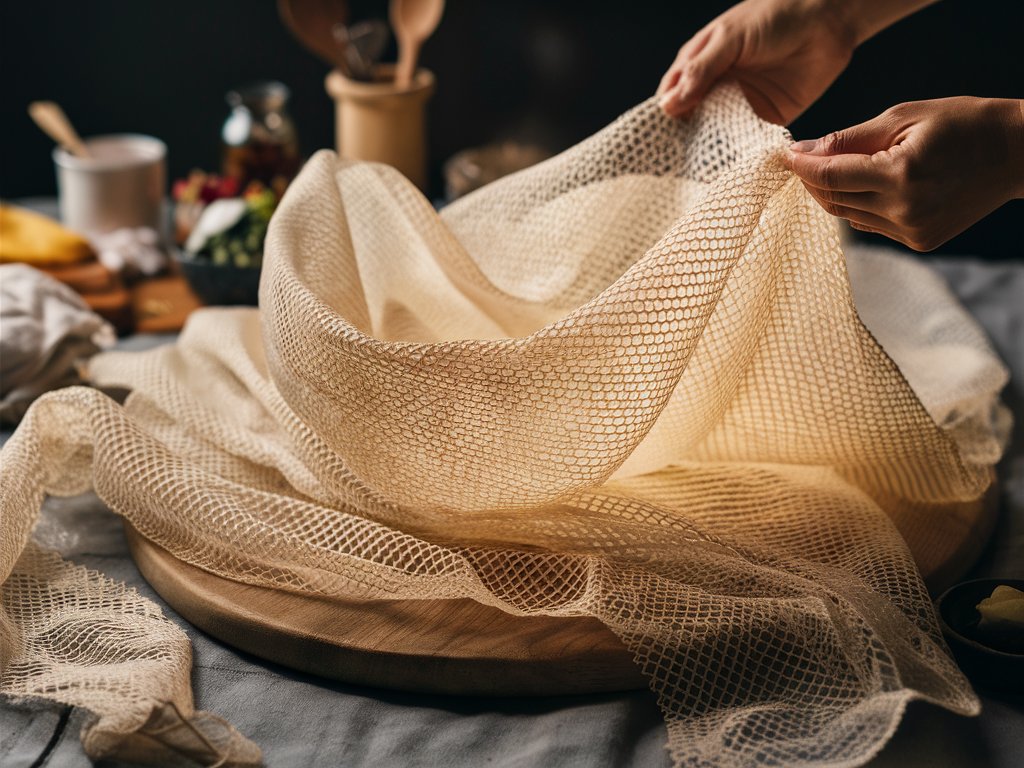Cheesecloth is an incredibly versatile fabric that has found its place not just in culinary uses but also in a variety of household and crafting applications. This lightweight, cotton cloth, known for its open weave, has a history that dates back centuries. Despite its name, cheesecloth’s utility extends far beyond cheese-making. We will explore the various types of cheesecloth, its numerous applications, and the benefits it offers. Whether you’re a home cook, a craft enthusiast, or someone looking to simplify household tasks, cheesecloth is an indispensable tool.
What is Cheesecloth?
Definition and Composition
Cheesecloth is a loosely woven cotton gauze fabric. The open weave design allows for excellent breathability and filtration, making it ideal for a range of uses. It is typically available in a variety of grades, which are determined by the number of threads per inch. The higher the grade, the finer and tighter the weave.
History of Cheesecloth
The use of cheesecloth dates back to ancient times. It was originally developed for the purpose of pressing and aging cheese, hence its name. Over time, its utility expanded into other culinary and household applications. Its durability and versatility have made it a staple in kitchens and homes around the world.
Types of Cheesecloth
Grades of Cheesecloth
Cloth comes in several grades, each suited for different purposes. Understanding these grades is crucial for selecting the right type for your needs.
- Grade 10: With the loosest weave, Grade 10 is typically used for basic tasks like covering plants, crafting, and cleaning.
- Grade 40: This mid-range grade is great for general kitchen use, including straining liquids and making cheese.
- Grade 50: Slightly finer than Grade 40, it’s used for more refined filtering tasks.
- Grade 60: This is ideal for tasks requiring a finer weave, such as preserving the clarity of strained liquids.
- Grade 90: With the finest weave, Grade 90 is perfect for highly detailed filtering and even for making certain delicate crafts.
Bleached vs. Unbleached Cheesecloth
They can be either bleached or unbleached. Bleached cheesecloth has been treated to remove natural colors and impurities, giving it a clean, white appearance. Unbleached cheesecloth, on the other hand, retains its natural color and is often preferred for culinary uses due to its chemical-free nature.
Also Read: Powerhouse: Ancient Grains in Healthy Cereal
Culinary Uses of Cheesecloth
Cheese Making
The most traditional use of cloth is in cheese making. It is used to wrap and press cheese, allowing whey to drain while retaining the curds. The cloth’s breathability is essential for proper aging and curing of cheese.
Straining and Filtering
Cheesecloth is perfect for straining stocks, broths, and sauces. Its fine weave catches impurities and solids, resulting in clear liquids. It’s also used for making nut milk, Greek yogurt, and other dairy alternatives.
Herb and Spice Bags
In cooking, cheesecloth can be used to create sachets for herbs and spices. These sachets can be added to soups, stews, and sauces to infuse flavor without leaving bits of herbs and spices in the dish.
Preserving and Jam Making
When making preserves and jams, cheesecloth is used to strain out seeds and pulp, ensuring a smooth consistency. It’s also handy for covering jars while they cool, keeping out debris and insects.
Household Uses of Cheesecloth
Cleaning and Dusting
Cheesecloth’s soft, lint-free nature makes it ideal for cleaning and dusting delicate surfaces. It can be used dry or dampened to wipe down furniture, windows, and other surfaces.
Polishing
When polishing silver, brass, and other metals, cheesecloth is a gentle yet effective tool. It holds polish well and leaves surfaces shiny and free of scratches.
Gardening
In gardening, cheesecloth can protect plants from pests and harsh sunlight. Its breathable fabric ensures plants get enough air and light while staying protected.
Crafting
Cheesecloth is a favorite material among crafters. It can be dyed, painted, and molded into various shapes, making it perfect for creating decorations, costumes, and other artistic projects.
Benefits of Using Cheesecloth
Versatility
One of the main benefits of cheesecloth is its versatility. It can be used in the kitchen, around the house, and in the garden. Its adaptability to different tasks makes it a valuable addition to any home.
Reusability
High-quality cheesecloth can be washed and reused multiple times, making it a cost-effective and environmentally friendly option. By reusing cheesecloth, you reduce waste and get more value out of your purchase.
Breathability
The open weave of cheesecloth allows for excellent air circulation. This breathability is crucial in culinary applications, such as cheese making and straining, where it helps prevent mold and bacteria growth.
Gentle on Surfaces
Cheesecloth is soft and non-abrasive, making it safe for use on delicate surfaces. Whether cleaning antiques, polishing metals, or dusting fragile items, cheesecloth’s gets the job done without causing damage.
How to Choose the Right Cheesecloth
Consider the Task
When selecting cheesecloth, consider the task at hand. For rough filtering and basic uses, a lower grade like 10 or 20 will suffice. For fine straining or detailed work, opt for a higher grade like 60 or 90.
Bleached vs. Unbleached
Decide whether you need bleached or unbleached cheesecloth’s. For culinary purposes, unbleached is often preferred due to its lack of chemical treatments. For household and crafting tasks, bleached cheesecloth is suitable and provides a clean, white appearance.
Reusability
If you plan to reuse your cheesecloth’s, invest in a higher quality grade. Higher grades are more durable and withstand washing better than lower grades.
Caring for Your Cheesecloth
Washing and Maintenance
Proper care extends the life of your cheesecloth. Rinse it immediately after use to remove food particles. For a thorough clean, hand wash with mild soap and warm water, then air dry. Avoid using fabric softeners or bleach, especially with unbleached cheesecloth’s, as these can affect its natural fibers.
Storage
Store cloth in a clean, dry place to prevent contamination and mildew growth. Folding it neatly and placing it in a resealable bag or container will keep it clean and ready for the next use.
Innovative Uses of Cheesecloth
Halloween Decorations
Cheesecloth can be transformed into spooky Halloween decorations. Its ghostly appearance when draped over objects or used to create ghost shapes adds an eerie touch to any Halloween setup.
Air Fresheners
Create DIY air fresheners by filling small cheesecloth’s sachets with dried herbs, flowers, or essential oils. Place these sachets in closets, drawers, or cars for a natural and pleasant scent.
Homemade Tea Bags
If you enjoy loose-leaf tea, cheesecloth’s can be used to make homemade tea bags. Cut small squares, fill with your favorite tea leaves, and tie with string for a convenient and eco-friendly tea bag.
Skin Care
They can be used in various skin care routines. It makes an excellent exfoliating cloth when used with a gentle cleanser. Additionally, it can be used to make homemade facial masks by soaking in herbal infusions and applying to the face.
Environmental Impact of Cheesecloth
Sustainable Choice
Cheesecloth, especially when unbleached, is a sustainable choice. It is biodegradable and can be composted after use. By choosing reusable cheesecloth’s, you also reduce the need for disposable alternatives, contributing to less waste.
Chemical-Free
Unbleached cheesecloth’s is free from harmful chemicals and dyes, making it a safer choice for food-related tasks and crafts. Its natural fibers are gentle on the environment and your health.
Conclusion
Cheesecloth is an incredibly versatile and valuable tool that extends far beyond its traditional role in cheese making. Its various grades and types make it suitable for an array of tasks, from culinary uses to household cleaning and crafting. The benefits of using cheesecloth include its reusability, breathability, and gentle nature, making it a practical and eco-friendly choice. Embrace the many uses of cheesecloth’s in your home and enjoy the simplicity and effectiveness it brings to your everyday tasks.




